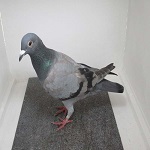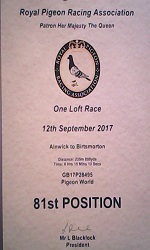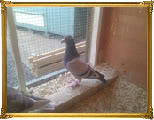| Countrywide Corns |  |
| Forum Syndicate 2019 | Pigeon World Forum Syndicate Bird takes 44th Place, in the 2019 RPRA One Loft Final.The Bird is Frans Zwol Bloodline, Bred and supplied by Darren Palmer (Oldstrain)  |
| Forum Syndicate 2019 | Pigeon World Forum Syndicate also takes 100th Place, in the 2019 RPRA One Loft Final. The Bird is Frans Zwol Bloodline, Bred and supplied by Darren Palmer (Oldstrain)

|
| Who is online? | In total there are 146 users online :: 0 Registered, 0 Hidden and 146 Guests :: 2 Bots None Most users ever online was 833 on Wed Nov 10, 2021 12:30 pm |
| Forum Syndicate 2017 | Pigeon World Syndicate Bird takes 81st Place in the 2017 Final Race, The Bird is Dia Evans Bloodlines and was Bred and supplied by Tumley Lofts Stud.  |
| R.P.R.A Certificate. | Pigeon World Forum Syndicate take 81st Place in the 2017 R.P.R.A. Final, with a Pigeon Bred and Supplied by Tumley Lofts Stud. |
| Top posting users this week | |
| Statistics | We have 1307 registered users
The newest registered user is ZionFerret
Our users have posted a total of 224349 messages in 14070 subjects
|
| Oldstrain/Darren`s Winner of winners. 2012. |  |
| From Fed Topper to Master Chef |  The N.E.H.U race from Melton Mowbray 21/4/2012 was won by Peel bros of South Shields, they took 1st club 1st fed, also taking 2nd and 4th club and 15 of the 25 birds clocked in the club......well done Peel brothers. The N.E.H.U race from Melton Mowbray 21/4/2012 was won by Peel bros of South Shields, they took 1st club 1st fed, also taking 2nd and 4th club and 15 of the 25 birds clocked in the club......well done Peel brothers. |
|
| | Pigeons Of War |  |
| | | Author | Message |
|---|
Rene A
Youngbird


Posts : 3867
Join date : 2010-01-24
Age : 54
Location : Guernsey
 |  Subject: Pigeons Of War Subject: Pigeons Of War  Thu Sep 23, 2010 10:45 pm Thu Sep 23, 2010 10:45 pm | |
| Cher Ami
(Dear Friend)
The ability to communicate is essential to soldiers in the field. Without communications to their commanders or support units in the rear area, soldiers on the front line can't send messages about their progress, request needed supplies, or call for help when things reach their worst.
During World War I, messages were sometimes transmitted by wire (telegraph or field phone), but two-way radio communications had not yet become available. Sometimes a unit was ordered to attack over a broad and often difficult terrain, making it impossible to string the wire necessary for communications. In these situations, a field commander often carried with him several carrier pigeons.
Pigeons served many purposes during the war, racing through the skies with airplanes, or even being fitted with cameras to take pictures of enemy positions. But one of the most important roles they served it was as messengers. An important message could be written on a piece of paper, then that paper neatly folded and secured in a small canister attached to a pigeon's leg. Once the pigeon was released, it would try to fly to its home back behind the lines, where the message would be read and transmitted to the proper military planners.
The United States Army is divided among several different specialties, the men from each specialty trained for a particular kind of work. Infantrymen are trained to fight on the ground, artillerymen are responsible for the big guns, armor refers to the men who fight in tanks, and the Air Service was the name for the group of soldiers who fought in the air during World War I.
One of the oldest of these groups of soldiers was the members of the U.S. ARMY SIGNAL CORPS. Since the birth of our Nation, it was these men that were responsible for insuring that messages between all units, (including messages to other branches of service like the Navy and Marines), got through. The Army Signal Corps identifies itself by a torch with two crossed flags. These represent SIGNAL FLAGS, a common way that messages were passed using code.
When the United States entered World War I in 1917, the Army Signal Corps was given 600 pigeons for the purpose of passing messages when it couldn't be done by signal flag or field phone. The pigeons were donated by bird breeders in Great Britain, then trained for their jobs by American soldiers.
During the Meuse-Argonne Offensive, the 2-month battle that finally ended World War I, 442 pigeons were used in the area of Verdun to carry hundreds of messages. This is how the system worked:
When a commander in the field needed to send a message, he first wrote it out on paper, trying to be both brief and yet as detailed as possible. Then he called for one of his Signal Corps officers, who would bring one of the pigeons that went with the soldiers into battle. The message would be put in the capsule on the birds leg, and then the bird would be tossed high in the air to fly home.
The carrier pigeon would fly back to his home coop behind the lines. When he landed, the wires in the coop would sound a bell or buzzer, and another soldier of the Signal Corps would know a message had arrived. He would go to the coop, remove the message from the canister, and then send it by telegraph, field phone or personal messenger, to the right persons.
Carrier pigeons did an important job. It was also very dangerous. If the enemy soldiers were nearby when a pigeon was released, they knew that the bird would be carrying important messages, and tried their best to shoot the pigeon down so the message couldn't be delivered.
Some of these pigeons became quite famous among the infantrymen they worked for. One pigeon named "The Mocker", flew 52 missions before he was wounded. Another was named "President Wilson". He was injured in the last week of the war and it seemed impossible for him to reach his destination. Though he lost his foot, the message got through to save a large group of surrounded American infantrymen.
Cher Ami
Probably the most famous of all the carrier pigeons was one named Cher Ami, two French words meaning "Dear Friend". Cher Ami several months on the front lines during the Fall of 1918. He flew 12 important missions to deliver messages. Perhaps the most important was the message he carried on October 4, 1918.
Mr. Charles Whittlesey was a lawyer in New York, but when the United States called for soldiers to help France regain its freedom, Whittlesey joined the Army and went to Europe to help. He was made the commander of a battalion of soldiers in the 77th Infantry Division, known as "The Liberty Division" because most of the men came from New York and wore a bright blue patch on their shoulders that had on it the STATUE OF LIBERTY.
On October 3, 1918 Major Whittlesey and more than 500 men were trapped in a small depression on the side of the hill. Surrounded by enemy soldiers, many were killed and wounded in the first day. By the second day only a little more than 200 men were still alive or unwounded.
Major Whittlesey sent out several pigeons to tell his commanders where he was, and how bad the trap was. The next afternoon he had only one pigeon left, Cher Ami.
During the afternoon the American Artillery tried to send some protection by firing hundreds of big artillery rounds into the ravine where the Germans surrounded Major Whittlesey and his men. Unfortunately, the American commanders didn't know exactly where the American soldiers were, and started dropping the big shells right on top of them. It was a horrible situation that might have resulted in Major Whittlesey and all his men getting killed--by their own army.
Major Whittlesey called for his last pigeon, Cher Ami. He wrote a quick and simple note, telling the men who directed the artillery guns where the Americans were located and asking them to stop. The note that was put in the canister on Cher Ami's left leg simply said:
"We are along the road parallel to 276.4.
"Our own artillery is dropping a barrage directly on us.
"For heaven's sake, stop it."
As Cher Ami tried to fly back home, the Germans saw him rising out of the brush and opened fire. For several minutes, bullets zipped through the air all around him. For a minute it looked like the little pigeon was going to fall, that he wasn't going to make it. The doomed American infantrymen were crushed, their last home was plummeting to earth against a very heavy attack from German bullets.
Somehow Cher Ami managed to spread his wings and start climbing again, higher and higher beyond the range of the enemy guns. The little bird flew 25 miles in only 25 minutes to deliver his message. The shelling stopped, and more than 200 American lives were saved...all because the little bird would never quit trying.
On his last mission, Cher Ami was badly wounded. When he finally reached his coop, he could fly no longer, and the soldier that answered the sound of the bell found the little bird laying on his back, covered in blood. He had been blinded in one eye, and a bullet had hit his breastbone, making a hole the size of a quarter. From that awful hole, hanging by just a few tendons, was the almost severed leg of the brave little bird. Attached to that leg was a silver canister, with the all-important message. Once again, Cher Ami wouldn't quit until he had finished his job.
Cher Ami became the hero of the 77th Infantry Division, and the medics worked long and hard to patch him up. When the French soldiers that the Americans were fighting to help learned they story of Cher Ami's bravery and determination, they gave him one of their own country's great honors. Cher Ami, the brave carrier pigeon was presented a medal called the French Croix de guerre with a palm leaf.
Though the dedicated medics saved Cher Ami's life, they couldn't save his leg. The men of the Division were careful to take care of the little bird that had saved 200 of their friends, and even carved a small wooden leg for him. When Cher Ami was well enough to travel, the little one-legged hero was put on a boat to the United States. The commander of all of the United States Army, the great General John J. Pershing, personally saw Cher Ami off as he departed France.
Back in the United States the story of Cher Ami was told again and again. The little bird was in the newspapers, magazines, and it seemed that everyone knew his name. He became one of the most famous heroes of World War I. Years after the war a man named Harry Webb Farrington decided to put together a book of poems and short stories about the men and heroes of World War I. When his book was published, it contained a special poem dedicated to Cher Ami:
Cher Ami
Cher Ami, how do you do!
Listen, let me talk to you;
I'll not hurt you, don't you see?
Come a little close to me.
Little scrawny blue and white
Messenger for men who fight,
Tell me of the deep, red scar,
There, just where no feathers are.
What about your poor left leg?
Tell me, Cher Ami, I beg.
Boys and girls are at a loss,
How you won that Silver Cross.
"The finest fun that came to me
Was when I went with Whittlesey;
We marched so fast, so far ahead!
'We all are lost,' the keeper said;
'Mon Cher Ami--that's my dear friend--
You are the one we'll have to send;
The whole battalion now is lost,
And you must win at any cost.'
So with the message tied on tight;
I flew up straight with all my might,
Before I got up high enough,
Those watchfull guns began to puff.
Machine-gun bullets came like rain,
You'd think I was an aeroplane;
And when I started to the rear,
My! the shot was coming near!
But on I flew, straight as a bee;
The wind could not catch up with me,
Until I dropped out of the air,
Into our own men's camp, so there!"
But, Cher Ami, upon my word,
You modest, modest little bird;
Now don't you know that you forgot?
Tell how your breast and leg were shot.
"Oh, yes, the day we crossed the Meuse,
I flew to Rampont with the news;
Again the bullets came like hail,
I thought for sure that I should fail.
The bullets buzzed by like a bee,
So close, it almost frightened me;
One struck the feathers of this sail,
Another went right through my tail.
But when I got back to the rear,
I found they hit me, here and here;
But that is nothing, never mind;
Old Poilu, there is nearly blind.
I only care for what they said,
For when they saw the way I bled,
And found in front a swollen lump,
The message hanging from this stump;
The French and Mine said, 'Tres bien,'
Or 'Very good'--American.
'Mon Cher Ami, you brought good news;
Our Army's gone across the Meuse!
You surely had a lucky call!
And so I'm glad. I guess that's all.
I'll sit, so pardon me, I beg;
It's hard a-standing on one leg!"
"Cher Ami" and Poems
by Harry Webb Farrington
Cher Ami died of his multiple war wounds on June 13, 1919--less than a year after he had completed his service to the United States Army Signal Corps. Upon his death a taxidermist preserved the small pigeon for future generations, a bird with a story that became an inspiration to millions over the years. |
|   | | notykinlofts
Hatchling


Posts : 627
Join date : 2009-08-19
Age : 61
Location : NORWICH Norfolk
 |  Subject: Re: Pigeons Of War Subject: Re: Pigeons Of War  Sat Sep 25, 2010 10:36 am Sat Sep 25, 2010 10:36 am | |
| lol i put this one on the forums a while back lol |
|   | | Rene A
Youngbird


Posts : 3867
Join date : 2010-01-24
Age : 54
Location : Guernsey
 |  Subject: Re: Pigeons Of War Subject: Re: Pigeons Of War  Sat Sep 25, 2010 11:56 am Sat Sep 25, 2010 11:56 am | |
| my two daughters done this in may for our liberation day celibrations of being liberayed from the Germans in 1945 |
|   | | notykinlofts
Hatchling


Posts : 627
Join date : 2009-08-19
Age : 61
Location : NORWICH Norfolk
 |  Subject: Re: Pigeons Of War Subject: Re: Pigeons Of War  Sat Sep 25, 2010 12:34 pm Sat Sep 25, 2010 12:34 pm | |
| more people should read this then maye they would respect our pgeons more |
|   | | David
Oldbird


Posts : 43859
Join date : 2009-03-18
Location : Leeds
 |  Subject: Re: Pigeons Of War Subject: Re: Pigeons Of War  Sat Sep 25, 2010 8:28 pm Sat Sep 25, 2010 8:28 pm | |
| ill have a read later on this evening when ive more time rene, looks interesting upon first glance tho..............thanks  |
|   | | Rene A
Youngbird


Posts : 3867
Join date : 2010-01-24
Age : 54
Location : Guernsey
 |  Subject: Re: Pigeons Of War Subject: Re: Pigeons Of War  Sat Sep 25, 2010 8:36 pm Sat Sep 25, 2010 8:36 pm | |
| hi mate im goin to put up all the pigeons of war that had the dickens medal awarded to them for thier galentry as well mate think there's 32 of them in all |
|   | | David
Oldbird


Posts : 43859
Join date : 2009-03-18
Location : Leeds
 |  Subject: Re: Pigeons Of War Subject: Re: Pigeons Of War  Sat Sep 25, 2010 8:55 pm Sat Sep 25, 2010 8:55 pm | |
| will look forward to reading it rene,  there was something in the homing world or rp weekly about the dickens medal birds i think rene....did you read it ? |
|   | | Rene A
Youngbird


Posts : 3867
Join date : 2010-01-24
Age : 54
Location : Guernsey
 |  Subject: Re: Pigeons Of War Subject: Re: Pigeons Of War  Sat Sep 25, 2010 8:58 pm Sat Sep 25, 2010 8:58 pm | |
| no mate i get the hand me downs from my mate lol |
|   | | David
Oldbird


Posts : 43859
Join date : 2009-03-18
Location : Leeds
 |  Subject: Re: Pigeons Of War Subject: Re: Pigeons Of War  Sat Sep 25, 2010 8:59 pm Sat Sep 25, 2010 8:59 pm | |
| it was in one of them rene, ill have a look through and tell you what it says......  |
|   | | Rene A
Youngbird


Posts : 3867
Join date : 2010-01-24
Age : 54
Location : Guernsey
 |  Subject: Re: Pigeons Of War Subject: Re: Pigeons Of War  Sat Sep 25, 2010 9:01 pm Sat Sep 25, 2010 9:01 pm | |
| yeh thanks mate im off for a bit but il put it up after wen i get back
|
|   | | David
Oldbird


Posts : 43859
Join date : 2009-03-18
Location : Leeds
 |  Subject: Re: Pigeons Of War Subject: Re: Pigeons Of War  Sat Sep 25, 2010 9:03 pm Sat Sep 25, 2010 9:03 pm | |
| ok rene, im off to watch alex reed in that fight on bravo soon so ill see when i get back..........  |
|   | | Sponsored content
 |  Subject: Re: Pigeons Of War Subject: Re: Pigeons Of War  | |
| |
|   | | | | Pigeons Of War |  |
|
Similar topics |  |
|
| | Permissions in this forum: | You cannot reply to topics in this forum
| |
| |
| |
